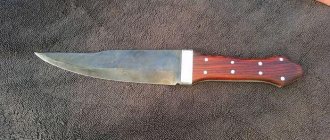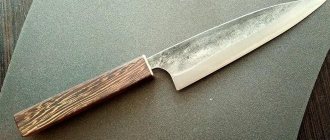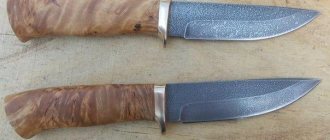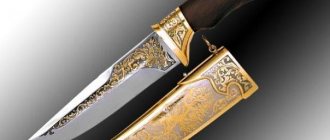A blade made by yourself is not only a guarantee of good quality, but also a certain “prestige” among friends. Making a knife from a file at home may seem like a daunting task. But with some skill and careful study of this material, almost anyone can cope with this. You need to take the process seriously and everything will work out.
A knife made from a file.
Required tools and materials
The process of making a knife involves many difficulties, including the selection of materials. For manufacturing, you need to select a file more than 3 cm wide; it is advisable to look for a Soviet-made tool. The cross-section of the file surface should be flat or diamond-shaped; if the latter is found, this will be the best option, since the shape of the steel is stronger and will withstand loads.
The manufacturing process will require the following tools and items:
- Rivets made of brass alloy.
- Etching is performed with ferric chloride.
- Magnet for checking the degree of hardening.
- To process surfaces you will need sandpaper.
Processing is carried out with a grinder or grinder. You also need to decide on the material of the handle of the future knife. A file knife can have a metal or wooden handle, its weight and purpose depend on this. Before manufacturing, it is worth preparing a sketch of the future product; usually it is drawn on paper.
The process of making a knife from a file
Blade sharpening
It is better to sharpen a knife manually, since when using an electric sharpener there is a danger of overheating the metal. A whetstone is usually used for sharpening. The procedure begins after etching is completed, after the epoxy resin has dried. The blade is fixed so that the sharpening angle is 20°.
- First, sharpening is done with a coarse abrasive sharpener (for example, an “extra-extra coarse” diamond stone). Processing is carried out exclusively in the direction perpendicular to the cutting edge. It is necessary to periodically wash the sharpener in soapy water. Having finished sharpening one side of the blade, turn it over and sharpen the second.
- Then they start fine-tuning. An “extrafine” diamond stone or a ceramic stone with a grain size of 1000 is suitable for this purpose. During finishing, the sharpening direction changes to the opposite (along the blade).
- The next stage is surface polishing. For this process, an extra-extra fine diamond stone or 8000 grit ceramic sharpener is used. The tool must move perpendicular to the edge of the knife blade. This rule must be observed during the final polishing of the product.
Periodic editing of the blade during use can be done with a musat - a rounded iron rod with notches, usually included in kitchen equipment sets. A household knife made from a file is highly durable and has a sharp blade. It can be used when working in the workshop, performing the most labor-intensive operations, without fear of quickly grinding down. It is also good as a throwing stiletto or an original gift for friends.
Firing the workpiece
The files are made from U10 steel, which is enriched with carbon; a file made from this steel is fragile and can easily crack under load. In order for the metal to be hard and not crumble when struck, it must be hardened. Usually the procedure is carried out in a special oven, the temperature of which reaches 700 °C.
To harden a knife made from a file, which you made yourself, you can use a regular gas stove.
The combustion temperature on the stove is not high, reaching no more than 300 degrees. To achieve the required heat, you need to use a kind of screen. In the absence of a special thermometer, you can use ordinary table salt, its melting point is equal to the hardening of knife steel.
Knife hardening
Hardening of the file is necessary only in the cutting part. Checking for uniform hardening occurs visually; after reaching the temperature, the knife should be uniformly reddish in color. The product must be kept at maximum temperatures for at least 4 hours. Cooling is done smoothly; if you cool the part right away, it will simply crack. Cooling of the part occurs through a gradual decrease in temperature; heating decreases every hour by a quarter of its initial intensity.
Heat treatment stage
Our instructions on how to make a knife from a file will help you quickly realize your dream of a quality tool. Homogeneous steel in the workpiece is excessively saturated with carbon, and this makes it brittle when subjected to severe mechanical damage.
Therefore, the main stage of knife manufacturing is the heat treatment of the file. It is calcined at a temperature of 600-700°C, followed by slow cooling. This is done in a regular burning stove, although you can also use a gas stove.
Under standard conditions, the specified temperature is not always achieved, so a thermal screen is constructed. It uses a metal plate, the dimensions of which allow it to cover the workpiece. The screen should rise more than 1 cm above the file being processed - bolts or nuts can be placed under it.
Only the section of the workpiece that is intended for the blade is annealed. It is sprinkled with table salt to control the process. If the coarse salt melts, then the desired temperature has been reached. The metal becomes cherry and retains the shade for more than 4 hours.
After warming up, the workpiece must cool down. This process is slow - the metal cools along with the furnace. It is necessary to gradually reduce the heat over the course of an hour. If this requirement is not met, the file will crumble.
How to harden a knife from a file
After firing, you can begin to form the future product. The workpiece is secured in a vice, the parts are processed with a grinder and all excess slag and layers of metal are removed. The sharpening machine is used with a coarse-grained abrasive wheel. The degree and shape of sharpening is carried out according to the prepared sketch. On the handle compartment you need to drill one or two holes to attach the handle.
After the tool is hardened from the file, it is necessary to treat the entire surface except the handle. A burner can be a tool for hardening, since the temperature is higher and the knife will harden faster. Uniform tempering of a knife from a file will give strength to the future product. The correct hardening of a knife made from a file can be determined with a magnet; if there is no reaction with the metal, then it is suitable for further use. After the process, the metal needs to be cooled, just put it in a bucket of water.
File knife and drawing for it
There is such a thing as metal stress. With this action, the metal crumbles and crumbles. To avoid adverse consequences, it is necessary to heat the instrument in the oven at the maximum temperature for several hours.
Forming, hardening and tempering is an important sequence!
In the workshop, holding the workpiece in a vice, we cut off and cut off unnecessary pieces, or grind it on a coarse-grained abrasive disk, giving the file a completely different shape - the shape of the future knife. If the knife is decorated with wood or other plates, do not forget to drill holes for rivets in the handle or cut a groove with a grinder.
Hardening is the next stage after formation. Many people make a big mistake, basing their assessment of the degree of hardening on the glow of the heated metal, but only an ordinary magnet can show the real picture - if the hot metal does not react in any way to its presence, then the hardening has been brought to the required degree. The future blade should be heated evenly, with the exception of the handle area; only a small area of 3-4 cm at the base of the blade should be heated. For this, it is best to use a burner that produces a higher temperature.
Also prepare a container of water in which you will cool the metal. When you achieve a uniform glow of the metal and the magnet stops reacting to it, warm the workpiece for a few more minutes, and then sharply plunge it into water - just like in the movies! If the process has been followed in every detail, the metal will be able to scratch the glass - this is the best sign of good tempering.
But due to the high internal pressure, hardened steel tends to break, crack and crumble when sharpened, so you need to temper it - a process through which internal stress is relieved while the hardness of the metal decreases slightly.
This is exactly what metal drills do! There is absolutely nothing complicated in the process itself - you just need to put the workpiece in the oven and bake it for an hour and a half at a temperature of about 200 ° C. The workpiece must cool down together with the oven!
Making the handle
Before making a handle for a product, you should decide on the appearance, materials and shape. You can use any material that is at hand. A wooden handle is considered a harmonious option.
File knife handle
The process includes several stages:
- Selection of materials, it is possible to use different types of wood for a unique design.
- It is necessary to make a bolster, the lower part of the knife. The remainder of a file or other metal is used.
- Wooden pieces are placed on top of each other and glued together with epoxy glue.
- To glue the pieces together better and faster, you need to use a press.
- The excess parts are trimmed with a saw, after which they are processed with sandpaper to the required shape.
- When finished, the handle is varnished for greater preservation; it is possible to use stain to darken it.
It is important to understand that all knives, regardless of category, are considered edged weapons. However, a cutting product whose blade length is no more than 90 cm and whose thickness is more than 6 mm can be removed from the category of edged weapons.
Sharpening is done in the usual way on a grinding machine.
The handle can be made of leather, deer antler or other materials. Installation depends on the form; each type requires an individual approach. The leather belt is tightly placed over the handle area, glued with special glue.
Forging metal before work
When you know blacksmithing and have the appropriate equipment, you can make a professional product. But why is forging needed if the workpiece already has a suitable shape:
- The metal gains higher strength and elasticity.
- The file is a little thick for the blade; when forming slopes, some of the metal will have to be removed. When forging, the metal will remain in the product; the thickness will simply be reduced.
- It will take less time for final processing.
In addition, you can remove the notches.
Although this is not necessary, because they give the products originality. If you don’t have special equipment, you can make a knife without forging. If you use high-quality blanks, you will get an excellent blade. Since the domestic market is filled with cheap Chinese tools, it is very difficult to find real Soviet tools. For inexpensive tools, use ordinary, highly hardened steel.
You can check the metal by placing a file on the edge of a table and then hitting it with a hammer. The hardened end will break, but the alloyed end will bend a little. You can also bring the tool to the sharpening machine. If the sparks are long, it’s ordinary steel; if they’re short and fluffy, you’re looking at a high-alloy metal. But heat treatment is necessary in any case: at a minimum, the workpieces are “tempered” and “hardened” again.
Proper processing
The initial processing of the knife blade is performed with any available tool. Sharpening a knife from a file can be done on a grinding machine, which will speed up the process and make the blade more uniform across the plane. The initial sharpening does not require ideal parameters, since the etching process occurs after it.
Etching the blade in citric acid
Etching occurs chemically using ferric chloride, which can be purchased at radio components or hardware stores. It is necessary to completely lubricate the product with the solution, or lower it into a flat container with it. The process will give the blade a film formed on the blade, which will provide protection and it is highly not recommended to remove it. At home, you can use citric acid mixed with vinegar for etching.
After all the processes carried out to process and produce a knife from a file, it is necessary to carry out final processing. The blade is carefully sharpened on a grinding machine to give it sharpness. The handle is polished with a solution of wax and turpentine or varnished.
Finishing the blade and handle - how to do it right?
After all these manipulations, you can begin finishing the blade. You can use all available tools that are intended for grinding: sandpaper, metal brushes, felt, vulcanite wheels, a grinding machine, etc. There is no need to be zealous - there is still an etching process ahead. Your task is to give the blade smoothness and bring its surface into a neat appearance.
Before etching, you can attach linings to the handle from the material we have planned, or wrap the metal with a strip of leather, it’s a matter of taste. In the first case, the finishing treatment must be carried out after etching, but leather can be wrapped already at this stage. You will need at least a half meter solid piece. First, do a simple wrap to see how the knife will look in this design, whether the piece of leather is long enough, and how the knife will feel in your hand. If you are happy with everything, unwind the handle and apply special leather glue to the back of the leather strip, carefully wrap the handle, this time trying as hard as you can.
A wooden handle will take longer to process. The holes for the rivets should be filled with epoxy resin, then the handle should be fastened with rivets and clamped in a vice until the resin has completely cooled. Two rivets will be enough. Once the resin has hardened, you can shape the handle, but do not rush into the final processing.
First - etching! If there is a radio store nearby, you can buy ferric chloride, in which the blade is etched until it obtains a gray, matte tint.
The film that forms on the blade will protect it from corrosion, so try not to remove it. If ferric chloride is too rare for you, pickling can be done with improvised means: vinegar, lemon juice or even ground raw potatoes! It is very important to clean the blades of any type of contamination, because when etching, even your fingerprints may appear on it, and then you will have to clean off the oxide film and start all over again.











